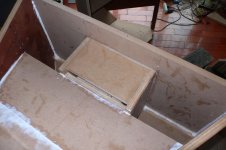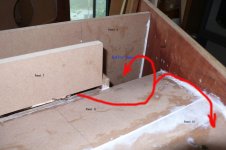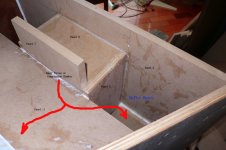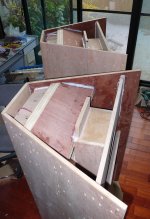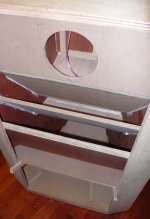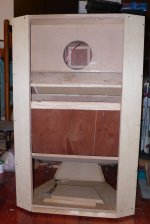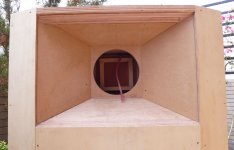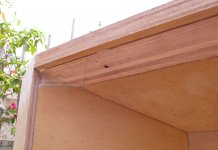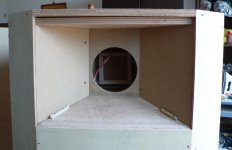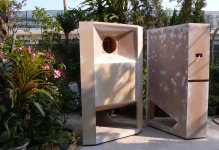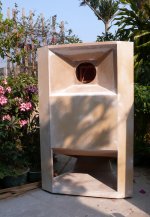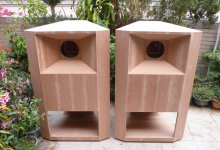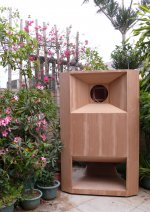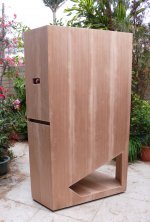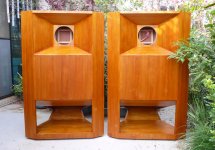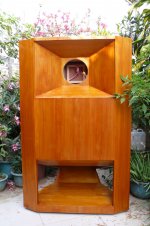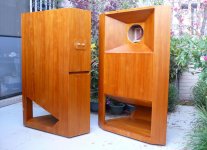Hi Peter,
Great jobs in making all these cabinets, especially this Opus One, just WOW!
And it's also great to see a speaker builder nearby (small island, after all😀 ) showing up here🙂 Please keep posting. We all love to see photos of woodworks😀
I noticed you've used both MDF and plywood in making this horn, are there any particular purposes? I might think of speading the intrinsic resonances of the materials themselves. How did you plan and decide which be applied to where? The back chamber alone has these two materials and they are (sort of) asymmetric! That's very bold!
As to the horn loading, I think this is a corner horn and should be pushed into a corner (as possible). The two side openings should meet the walls in a very close distance and the walls (and floor) form the last section of the horn - like a K-horn or other corner horns. And this should be the reason of the angle of the 2 side walls, which is obvious less than 90 degree - to make some room both sides when located at an ordinary 90 degree corner.
I think the actual size of the terminus (distance to wall) and the angle are crucial to the last section of horn flare. A corner horn which is not placed right at the corner would make the actual horn shorter and mouth (abruptly) bigger, which is not a good thing in loading the LF.
Have been playing with a famous simulation tool - Hornresp, I've found a corner horn which leaves the corner would certainly have less SPL in LF and probably more ragged response. A few experiences with K-horn reveal similar results, so please try to locate your horn into the corner as possible, and you'll surely have some differences. I'd expect deeper, louder, and even smoother bass 😀
CLS🙂
Great jobs in making all these cabinets, especially this Opus One, just WOW!
And it's also great to see a speaker builder nearby (small island, after all😀 ) showing up here🙂 Please keep posting. We all love to see photos of woodworks😀
I noticed you've used both MDF and plywood in making this horn, are there any particular purposes? I might think of speading the intrinsic resonances of the materials themselves. How did you plan and decide which be applied to where? The back chamber alone has these two materials and they are (sort of) asymmetric! That's very bold!
As to the horn loading, I think this is a corner horn and should be pushed into a corner (as possible). The two side openings should meet the walls in a very close distance and the walls (and floor) form the last section of the horn - like a K-horn or other corner horns. And this should be the reason of the angle of the 2 side walls, which is obvious less than 90 degree - to make some room both sides when located at an ordinary 90 degree corner.
I think the actual size of the terminus (distance to wall) and the angle are crucial to the last section of horn flare. A corner horn which is not placed right at the corner would make the actual horn shorter and mouth (abruptly) bigger, which is not a good thing in loading the LF.
Have been playing with a famous simulation tool - Hornresp, I've found a corner horn which leaves the corner would certainly have less SPL in LF and probably more ragged response. A few experiences with K-horn reveal similar results, so please try to locate your horn into the corner as possible, and you'll surely have some differences. I'd expect deeper, louder, and even smoother bass 😀
CLS🙂
Lowther Opus one model B
Dear Andrew,
I am glad of your interesting and response in this project.
I think you don't need to worry about the design. The drawing of Opus one model B has no big problem, just some minor errors. Cutting and assembly of the panels don’t need to be very accurate, but should be as accurate as possible you can do. Mating tightly would be more important. I cut the panels as accurate as possible and still found many edges need to be scraped out a little. That is not the fault of the design inaccurate, but because of the accumulation of the inaccuracy from the pre-drawing, cutting and assembly. Cutting the panels a little more than the designed dimensions, about 0.5-1 mm, will allow the assembly work easier.
I also struggled in the selection of big cabinet, Audiovector, Tp1, and Opus one . Finally, I select Opus one model B, mainly because I want to experiment that a pair of well-designed speaker can be placed into corners. Some local audiophile told me that it is stupid to put loudspeakers into the corners; the bass will be blurred; except that you have ear problems. Another reason is that I want to test the performance of the strongest driver PM4A. Opus one B is very suitable for PM4A.
Remember that parallel panels inside the cabinet, parallel panels on the horn mouth, and paralls between cabinets and outside walls will result different kind of resonances. A little resonance maybe good to the sound. But the corner which physically enhances those resonances seems to be harmful, especially to the bass.
My 2 cents idea for your reference.
Hello Peter,
Please keep posting about your project.
I have been planning for about 1 year now to build a pair of Lowther Horns, either the TP1 ISIS or the OPUS like you but have been told that the designs from Lowther on the CD are inaccurate which you are also saying. I may still order the cd anyway and measure and cut as I go along if I ever decide which ones to build.
Congratulations on your project.
Andrew
Dear Andrew,
I am glad of your interesting and response in this project.
I think you don't need to worry about the design. The drawing of Opus one model B has no big problem, just some minor errors. Cutting and assembly of the panels don’t need to be very accurate, but should be as accurate as possible you can do. Mating tightly would be more important. I cut the panels as accurate as possible and still found many edges need to be scraped out a little. That is not the fault of the design inaccurate, but because of the accumulation of the inaccuracy from the pre-drawing, cutting and assembly. Cutting the panels a little more than the designed dimensions, about 0.5-1 mm, will allow the assembly work easier.
I also struggled in the selection of big cabinet, Audiovector, Tp1, and Opus one . Finally, I select Opus one model B, mainly because I want to experiment that a pair of well-designed speaker can be placed into corners. Some local audiophile told me that it is stupid to put loudspeakers into the corners; the bass will be blurred; except that you have ear problems. Another reason is that I want to test the performance of the strongest driver PM4A. Opus one B is very suitable for PM4A.
Remember that parallel panels inside the cabinet, parallel panels on the horn mouth, and paralls between cabinets and outside walls will result different kind of resonances. A little resonance maybe good to the sound. But the corner which physically enhances those resonances seems to be harmful, especially to the bass.
My 2 cents idea for your reference.
Last edited:
Lowther Opus one model B
I use both MDF and plywood together just because I want to completely use all materials up. 😀
Originally I plan to use MDF for all panels. However, I can’t find large enough MDF panels for the side panels in local woodshops, so that I use plywood instead. I try to make use of remains of plywood. Almost panels are made of MDF.
Checking all lowther cabinets designs, I found that Audiovector uses plywood, Acousta 115 uses blockboards, TP1 could use plywood Or MDF, and Opus one uses MDF. So, I judged that both MDF and plywood are good materials for horn.
I heard that the type and origins of woods are very important to horn build. Even somebody said they have listened that their horn made of birch plywood imported from northern Europe, 10 times more expensive, has better performance than the plywood or MDF from Southeast Asia. I always doubt that and wonder whether it is worthy. I think that the horn is designed to transmit the sound wave in a path from the throat to the mouth and resonant in the path should be as little as possible. Since the resonant or sound reflex in a well designed horn is very minor, any kind of material, if tough enough, could be used. The physical principle of horn is different from the ones of bass reflex cabinet. I think that the design of horn is much more important than the material selection. Also, the path dimensions of folded horn have many errors than theoretical one.
I highly appreciate that someone can offer a physical explanation or objective measurement to proof above issue.
Dear CLS, thanks a lot for your advice on horn placement. I have already put the horn getting into the corner. I will experiment the sound difference of different distance and angle against the room wall.
Best Regards,
Hi Peter,
Great jobs in making all these cabinets, especially this Opus One, just WOW!
And it's also great to see a speaker builder nearby (small island, after all😀 ) showing up here🙂 Please keep posting. We all love to see photos of woodworks😀
I noticed you've used both MDF and plywood in making this horn, are there any particular purposes? I might think of speading the intrinsic resonances of the materials themselves. How did you plan and decide which be applied to where? The back chamber alone has these two materials and they are (sort of) asymmetric! That's very bold!
As to the horn loading, I think this is a corner horn and should be pushed into a corner (as possible). The two side openings should meet the walls in a very close distance and the walls (and floor) form the last section of the horn - like a K-horn or other corner horns. And this should be the reason of the angle of the 2 side walls, which is obvious less than 90 degree - to make some room both sides when located at an ordinary 90 degree corner.
I think the actual size of the terminus (distance to wall) and the angle are crucial to the last section of horn flare. A corner horn which is not placed right at the corner would make the actual horn shorter and mouth (abruptly) bigger, which is not a good thing in loading the LF.
Have been playing with a famous simulation tool - Hornresp, I've found a corner horn which leaves the corner would certainly have less SPL in LF and probably more ragged response. A few experiences with K-horn reveal similar results, so please try to locate your horn into the corner as possible, and you'll surely have some differences. I'd expect deeper, louder, and even smoother bass 😀
CLS🙂
I use both MDF and plywood together just because I want to completely use all materials up. 😀
Originally I plan to use MDF for all panels. However, I can’t find large enough MDF panels for the side panels in local woodshops, so that I use plywood instead. I try to make use of remains of plywood. Almost panels are made of MDF.
Checking all lowther cabinets designs, I found that Audiovector uses plywood, Acousta 115 uses blockboards, TP1 could use plywood Or MDF, and Opus one uses MDF. So, I judged that both MDF and plywood are good materials for horn.
I heard that the type and origins of woods are very important to horn build. Even somebody said they have listened that their horn made of birch plywood imported from northern Europe, 10 times more expensive, has better performance than the plywood or MDF from Southeast Asia. I always doubt that and wonder whether it is worthy. I think that the horn is designed to transmit the sound wave in a path from the throat to the mouth and resonant in the path should be as little as possible. Since the resonant or sound reflex in a well designed horn is very minor, any kind of material, if tough enough, could be used. The physical principle of horn is different from the ones of bass reflex cabinet. I think that the design of horn is much more important than the material selection. Also, the path dimensions of folded horn have many errors than theoretical one.
I highly appreciate that someone can offer a physical explanation or objective measurement to proof above issue.
Dear CLS, thanks a lot for your advice on horn placement. I have already put the horn getting into the corner. I will experiment the sound difference of different distance and angle against the room wall.
Best Regards,
Hello,
a bass horn is always to short and to small,
so the flare rate and length is most important,
and the material,
my experience shows birch multiplex 18 mm (10 cross layers)
in combination with softfiber the first m and the press chamber
will reduce colloration at the upper horn frequency range.
look my HP, with mesurements and compair it to other horn responces.
BTW: did someone a measurement from the OPUS and a IMP,
IMHO the OPUS is much to large for the result,
look my ALPHORN with SCHALMEI, SAXOPHON, RDH20
a bass horn is always to short and to small,
so the flare rate and length is most important,
and the material,
my experience shows birch multiplex 18 mm (10 cross layers)
in combination with softfiber the first m and the press chamber
will reduce colloration at the upper horn frequency range.
look my HP, with mesurements and compair it to other horn responces.
BTW: did someone a measurement from the OPUS and a IMP,
IMHO the OPUS is much to large for the result,
look my ALPHORN with SCHALMEI, SAXOPHON, RDH20
Hi, Dear hm
Thanks for your offer the experience of combination materials used in compression chamber.
You are genius for horn design. Horn-Sat + Alphorn looks very impressive.
Best Regards,
Thanks for your offer the experience of combination materials used in compression chamber.
You are genius for horn design. Horn-Sat + Alphorn looks very impressive.
Best Regards,
Hello,
my experience shows birch multiplex 18 mm (10 cross layers)
in combination with softfiber the first m and the press chamber
will reduce colloration at the upper horn frequency range.
Lowther uses the Bicor idea to reduce resonant or coloration for Opus one by adding a throat in the compression chamber. The area of added throat is about 1/3 of horn throat. There is no need to add damping material in the compression chamber for Opus one.
Hello,
bicor effect: make a IMP with and without the Bicor effect
than you will see where it work,
IMHO it has nothing to do with colorations over ~200 Hz.
bicor effect: make a IMP with and without the Bicor effect
than you will see where it work,
IMHO it has nothing to do with colorations over ~200 Hz.
Dear HM,
I don't understand what you mean.
Would you please write them by German?
I could try to translate in my way.
What is the definition of IMP?
Danke.
I don't understand what you mean.
Would you please write them by German?
I could try to translate in my way.
What is the definition of IMP?
Danke.
Lowther Opus One model B
When the build progress so far neared to the ending, I found there are more questions than answer.
The compression chamber has second upper throat which called Bicor devised by Lowther. The lower throat matches a pair of divided panels to gradually expand the horn contour; however, the upper throat doesn’t connect to any dividing panel. Even there is a big empty space around the compression chamber connected to the upper throat. Since the area of the upper throat is about 1/3 of the horn throat, physically 1/3 of the sound wave from compression chamber will escape to that buffer space. I wrote an email to Lowther Company asking whether it is a need to add two panels to block that buffer space, and should I add some damping materials into that buffer space. Kindly Lowther quickly replied that there is no need to add any panel and damping material, and “bicor systems should always have a large chamber area before restricting the outlet”.
When the build progress so far neared to the ending, I found there are more questions than answer.
The compression chamber has second upper throat which called Bicor devised by Lowther. The lower throat matches a pair of divided panels to gradually expand the horn contour; however, the upper throat doesn’t connect to any dividing panel. Even there is a big empty space around the compression chamber connected to the upper throat. Since the area of the upper throat is about 1/3 of the horn throat, physically 1/3 of the sound wave from compression chamber will escape to that buffer space. I wrote an email to Lowther Company asking whether it is a need to add two panels to block that buffer space, and should I add some damping materials into that buffer space. Kindly Lowther quickly replied that there is no need to add any panel and damping material, and “bicor systems should always have a large chamber area before restricting the outlet”.
Attachments
Peter,
imp = measurement of impedance,
i saw a lowther plan from the sixties
using softfibre,
dont underestimate the inner reflexions
in the press chamber.
imp = measurement of impedance,
i saw a lowther plan from the sixties
using softfibre,
dont underestimate the inner reflexions
in the press chamber.
When the build progress so far neared to the ending, I found there are more questions than answer.
The compression chamber has second upper throat which called Bicor devised by Lowther. The lower throat matches a pair of divided panels to gradually expand the horn contour; however, the upper throat doesn’t connect to any dividing panel. Even there is a big empty space around the compression chamber connected to the upper throat. Since the area of the upper throat is about 1/3 of the horn throat, physically 1/3 of the sound wave from compression chamber will escape to that buffer space. I wrote an email to Lowther Company asking whether it is a need to add two panels to block that buffer space, and should I add some damping materials into that buffer space. Kindly Lowther quickly replied that there is no need to add any panel and damping material, and “bicor systems should always have a large chamber area before restricting the outlet”.
Peter,
That's a very complicated project. My hats off to you for having the ability to work through this task and it's many problems. Excellent work!
Tom Scata (thetubeguy1954)
========================================================
"The man that hath no music in himself nor is not moved with concord of sweet sounds is fit for treasons, stratagems and spoils."
- William Shakespeare
Peter,
i saw a lowther plan from the sixties
using softfibre,
dont underestimate the inner reflexions
in the press chamber.
I agree.
A Lowther plan from the sixties? Maybe it is Acousta?
I can hear some HF resonance coming out from horn mouth of my Acousta 115.
Lowther suggests "blockboard" for Acousta, I use plywood instead.
The compression chamber of Acousta 115 is so wide but short in depth, an apparent geometry of resonance.
It is a great idea to adhere a thin softfiber layer in the compression chamber of Acousta 115.
Opus one has no such problem. The inner space of compression chamber is almost occupied by the very big magnet of PM4A.
The sound of Opus is very clear. I can't hear resonance from its horn mouth.
Last edited:
Lowther Opus One model B
The next step is to assembly the horn mouth panels and its inner bent panel. Those panels are very big and complicated and have to mate with many panels, including of: two side panels, two front-side long panels and a front panel. The front panel 25mm, between two long front panels(not shown), also mates with lower panel of front horn. In this stage, I spent a lot time to correct errors by a scraper, and carefully pre-assembly all above panels by screws and wood sticks. The lower front horn panel and inner bent panel (not shown) need to be glued first, then all other panels are glued together in the same time quickly. I was very careful to arrange the assembly order. I don’t want finding some panel unable to put into the enclosure latter. 😡
Thanks guys for all your responses. This is really a very complicated and difficult project. However, after I listened to its sound, it is absolutely worthy of all hard working. 🙂
The next step is to assembly the horn mouth panels and its inner bent panel. Those panels are very big and complicated and have to mate with many panels, including of: two side panels, two front-side long panels and a front panel. The front panel 25mm, between two long front panels(not shown), also mates with lower panel of front horn. In this stage, I spent a lot time to correct errors by a scraper, and carefully pre-assembly all above panels by screws and wood sticks. The lower front horn panel and inner bent panel (not shown) need to be glued first, then all other panels are glued together in the same time quickly. I was very careful to arrange the assembly order. I don’t want finding some panel unable to put into the enclosure latter. 😡
Thanks guys for all your responses. This is really a very complicated and difficult project. However, after I listened to its sound, it is absolutely worthy of all hard working. 🙂
Attachments
Lowther Opus One model B
The design drawing of side panels of front horn has some errors. You can’t place them in position without correction. I wish that I could post the corrected drawing here without violating Lowther’s copyright.
I think that I don’t need all grille cloth frames on front horn, mouth and side vents. I decide to eliminate all related rebate to make the enclosure look simpler. The upper panel of the front horn and the top panel for installing grille cloth frame are modified to match smoothly as shown.
The first photo is the original design as your reference.(the upper panel of front horn is not shown)
The design drawing of side panels of front horn has some errors. You can’t place them in position without correction. I wish that I could post the corrected drawing here without violating Lowther’s copyright.
I think that I don’t need all grille cloth frames on front horn, mouth and side vents. I decide to eliminate all related rebate to make the enclosure look simpler. The upper panel of the front horn and the top panel for installing grille cloth frame are modified to match smoothly as shown.
The first photo is the original design as your reference.(the upper panel of front horn is not shown)
Attachments
Lowther Opus One model B
The last three steps are makeover, veneer, and painting.
The last three steps are makeover, veneer, and painting.
Attachments
The last three steps are makeover, veneer, and painting.
Peter,
My congrats on building a very complicated & difficult speaker. I'm sure you'll now be rewarded with countless hours of musical enjoyment, that will make going through the process of building them worth every single minute it took to finish them!
Tom Scata (thetubeguy1954)
================================================== =======
"The man that hath no music in himself nor is not moved with concord of sweet sounds is fit for treasons, stratagems and spoils."
- William Shakespeare
Congratulations Peter,
They look great.
I do not know how long you have had them playing but do you think that the end result or all of that hard labour and effort were worth it?
Are they that much better than the other Lowther horns you had before?
Again, congratulations, they look excellent.
Thanks
Andrew
They look great.
I do not know how long you have had them playing but do you think that the end result or all of that hard labour and effort were worth it?
Are they that much better than the other Lowther horns you had before?
Again, congratulations, they look excellent.
Thanks
Andrew
Lowther Opus One model B
Dear Tom,
Thanks your congratulations. Since you are so interested in this project; if you have two strong corners in your stereo room, I strongly suggest you make them by yourself. You should buy a 10” Bench saw first. The operating manual will tell you how to saw woods accurately. I am not a woods professional. I asked all questions to many local woodshop.
Their sound is wonderful. Their performance is absolutely worthy to build. Don’t buy or order them from shop. They are laborious to build, of course very expensive. That is why I unveil all the difficulties and secretes of this project here. I think this is not the most difficult project, and you can build them by only your two hands.
Regards,
Peter,
My congrats on building a very complicated & difficult speaker. I'm sure you'll now be rewarded with countless hours of musical enjoyment, that will make going through the process of building them worth every single minute it took to finish them!
Tom Scata (thetubeguy1954)
Dear Tom,
Thanks your congratulations. Since you are so interested in this project; if you have two strong corners in your stereo room, I strongly suggest you make them by yourself. You should buy a 10” Bench saw first. The operating manual will tell you how to saw woods accurately. I am not a woods professional. I asked all questions to many local woodshop.
Their sound is wonderful. Their performance is absolutely worthy to build. Don’t buy or order them from shop. They are laborious to build, of course very expensive. That is why I unveil all the difficulties and secretes of this project here. I think this is not the most difficult project, and you can build them by only your two hands.
Regards,
- Status
- Not open for further replies.
- Home
- Loudspeakers
- Full Range
- Lowther Opus One Model B Build Thread
